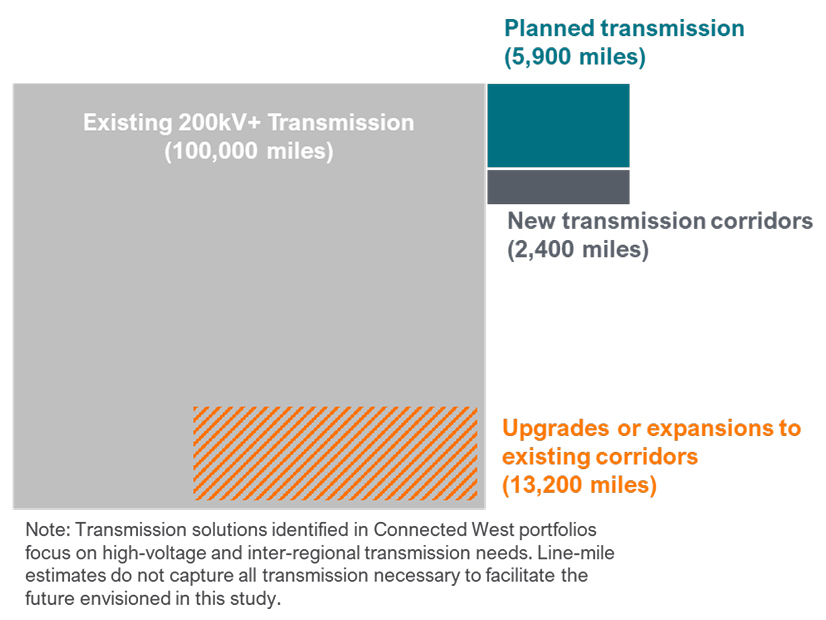
The Western Interconnection will need about 15,600 new line miles of high-voltage transmission at a cost of about $75 billion over the next 20 years to meet the anticipated increase in load growth, according to a report commissioned by Gridworks and GridLab published Sept. 23.
Conducted for the two groups by Energy Strategies, the Connected West study found that the Western grid’s reliability is at risk even if $30 billion of planned grid investments are implemented in the next decade. The current planned investments represent approximately 5,900 line miles, which may not be enough to support “an electrified and deeply decarbonized Western grid in 2045,” according to the report.
Instead, the report recommends an additional 15,600 new line miles over 20 years. The study found that approximately 85% of the new transmission capacity across the West can be achieved by upgrading existing corridors. Some 2,400 miles of new greenfield transmission would be needed for the proposed transmission system, the report said.
“The high-voltage investment gap to support reliability and efficiency of the grid, representing the next tranche of regional-scale transmission investments not currently planned for, is on the order of at least $75 billion,” the report said. “This investment, at a minimum, is necessary to address the transmission constraints identified in the Connected West scenario.”
The report added that the investment gap “should be considered a ‘floor’ not a ‘ceiling’ of future transmission need.”
Casey Baker, senior program manager for GridLab, said in an email to RTO Insider that the study provides stakeholders with recommendations on how to complete transmission plans “that can be implemented in the various FERC Order 1920 compliance efforts kicking off in regions around the country.” (See FERC Open Meeting Showcases Order 1920 Rehearing Debate.)
“Transmission stakeholders can take the Connected West study and use it in their efforts to promote best practices as their regions move towards completing their own long range transmission plans,” Baker added.
The study builds on the Nature Conservancy’s 2022 Power of Place: West report, which explored the land use requirements and conservation impacts of achieving net-zero greenhouse gas emissions across the Western U.S.
Connected West leveraged Nature Conservancy’s findings to analyze transmission needs for a high electrification scenario involving various clean energy technologies, according to the report. The study evaluated three transmission expansion portfolios, with each portfolio exploring different pathways to improve grid capacity, reliability and efficiency.
Baker noted that although the costs are significant, “the benefit to cost ratio for all three portfolios was approximately 1.4 and assumed significant (approximately 70%) load growth over the next 20 years which could be leveraged to support this investment.”
Total benefits from the new transmission explored in Connected West would be between $250 billion to $275 billion, including up to $150 billion in avoided investments in power plants, $50 billion in avoided losses from extreme weather and $35 billion in reduced energy costs, among other benefits, according to the report.
“Our analysis shows that this level of expansion is not only achievable but necessary to meet the energy demands of the future,” Matthew Tisdale, executive director of Gridworks, said in a news release. “With proper planning, we can build the infrastructure needed to support a robust economy while minimizing costs. Simply put: it will be better for ratepayers, businesses and communities in the West if we make the right investments now to avoid higher costs and greater disruptions later.”
‘Unprecedented’
The Connected West study appears well-positioned to contribute to Western transmission discussions as two parallel efforts ramp up to spur development of the kind of interregional projects the region has struggled to build.
One of those is the Western Power Pool’s Western Transmission Expansion Coalition (WestTEC), which is being guided by electricity industry participants.
The other is the Western States Transmission Initiative (WSTI), which is being facilitated by Gridworks on behalf of the Committee on Regional Electric Power Cooperation’s membership of state energy agency officials. (See In West, Proposals for Tx Planning Proliferate Faster than New Lines.)
Baker called Connected West an “unprecedented study that provides a template for completing a 20-year, holistic, multi-benefit transmission plan.”
“Many other entities including WECC, CAISO, and the U.S. [Department of Energy] have completed 20-year transmission studies, but this is the first long-range transmission plan to integrate economy-wide decarbonization, multiple benefit streams, transmission technology portfolios and environmental siting considerations across the entire Western grid,” he said.


